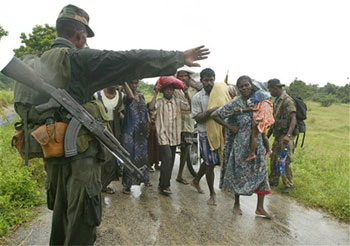Ilankai Tamil Sangam30th Year on the Web Association of Tamils of Sri Lanka in the USA |
|||||
 Home Home Archives Archives |
Sri Lankan Disasters: Natural and Man-Madeby Richard M. Walden, TruthDig.com, January 16, 2007
How weird can things get in Sri Lanka? Since 1983, a mostly Hindu Tamil minority (18% of the population) has been waging an exceptionally bloody civil war against the Sinhala majority, most of whom are Sinhalese-speaking Buddhists. A 2001 cease-fire agreement, shaky from the start, fell apart in wake of the government’s clear bias in distributing aid given in response to the disaster of Dec. 26, 2004: Two-thirds of Sri Lanka’s tsunami victims are in the Tamil-controlled north and east of the country, but the government has all but ignored them in its desperate race to rebuild lucrative tourist areas on island’s western Sinhala-dominated “gold coast.” To make matters geopolitical, there is the issue of India, a regional power that has tens of millions of its own Tamil population but which, after having earlier supported a more moderate Sri Lanka government, now has backed off to a position of studied neutrality between the two sides. Filling the void are none other than Pakistan and Israel, which have become suppliers of Sri Lanka’s military. Yes, Pakistan and Israel together! Maybe not breaking bread but certainly providing simultaneous services to a military client state. This has become a most ugly conflict, as Tamil Tiger separatists use the government’s anti-Tamil actions as a pretext to renew the group’s claims for total independence: The extremist leaders elected a year ago to replace a moderate Sinhalese pro-peace government left no doubt upon assuming power that they would torpedo the peace process and not share tsunami aid equitably. (Think what our response would have been had FEMA stated that New Orleans did not deserve Hurricane Katrina support funds because it has a predominantly black, Democratic electorate.) Into this melee steps the international relief community, with its witch’s brew of relief and recovery programs ranging from post-traumatic stress counseling to grants to job re-creation to simply rebuilding houses and replacing thousands of lost fishing boats. Operation USA is one such group. A small, Los Angeles-based relief agency of which I am founder and president, our organization’s coffers swelled with generous donations after the tsunami. We have focused most of our aid on Tamils, Muslims and Sinhala in Sri Lanka, and the Acehnese in Banda Aceh, Indonesia. When a Tamil relief group laid out a number of places where the U.S. group might target its aid, Operation USA chose the more challenging path of working in Tamil-controlled areas, as opposed to government-controlled ones, on the assumption that government-supplied aid to Tamil areas might not be forthcoming. Despite any number of obstacles, the east coast fishing village of Kallady was nearly rebuilt from the ground up—briefly enjoying new houses, schools, a clinic, a fishing fleet, extensive water systems and much more. Eighteen months of work and more than $1 million went into Kallady’s recovery. Just as the finishing touches were being completed last August, escalating violence in the north and east led to much tighter government roadblocks—cutting off most fuel for boats, cement for construction, and medicine and food. And later that fall came the bombing and shelling of Tamil areas, including Kallady, and the murder of 17 ethnic Tamil aid workers employed by the French aid group Action Against Hunger. Much of the Tamil population, along with the families of the 17 murder victims, point to undisciplined government troops as the likely culprits. The shelling of Kallady destroyed several homes in the village and caused all 600 residents to flee to Vaharai, a town a two-day walk away and with a fresh population of thousands of internally displaced Tamils. Vaharai itself was strafed and shelled, causing at least 40 deaths and hundreds of wounded. A virtual free-fire zone now reigns in the east and north of Sri Lanka as the government seeks to destroy the Tamil Tigers’ ability to respond militarily—an unlikely eventuality, given the group’s proven mettle. The widespread artillery barrages and bombing runs with Israeli-supplied Kfir fighter-bombers have vastly increased the number of casualties on the Tamil side. The relatively inexperienced Sri Lanka air force, emboldened with its new toys and given a green light by an aggressive and nativist civilian government, has struck clumsy, inaccurate but devastating blows against Sri Lanka’s Tamil population. This has created a significant new refugee flow across the 12-mile-wide Palk Strait to India’s Tamil Nadu region, and has internally displaced hundreds of thousands of people in both Tamil- and government-controlled areas. It is thus not surprising that the World Bank and bilateral governmental donors have withheld billions of dollars pledged to rebuild tsunami-damaged areas of Sri Lanka. Former President Bill Clinton, in his United Nations-appointed role as special representative for tsunami recovery, pointedly did not visit Sri Lanka last month on his valedictory trip through the 11-nation area struck by the waves. International relief agencies have also withheld funds or become discouraged with Sri Lanka’s government, and not only because of its high-handedness with its Tamil minority. Several governmental policies have badly affected the pace of the well-financed massive relief operation that once held so much promise. Among those policies: taxing of importation of relief supplies; overly prescriptive building regulations that delay new housing construction; and a host of new measures to allow more governmental control over the operation of local and international groups. Richard M. Walden is President, CEO and Founder of Operation USA (also known as Operation California), a Los Angeles-based nongovernmental organization specializing in disaster relief as well as international and domestic health care and economic development projects. |
||||
|
|||||
